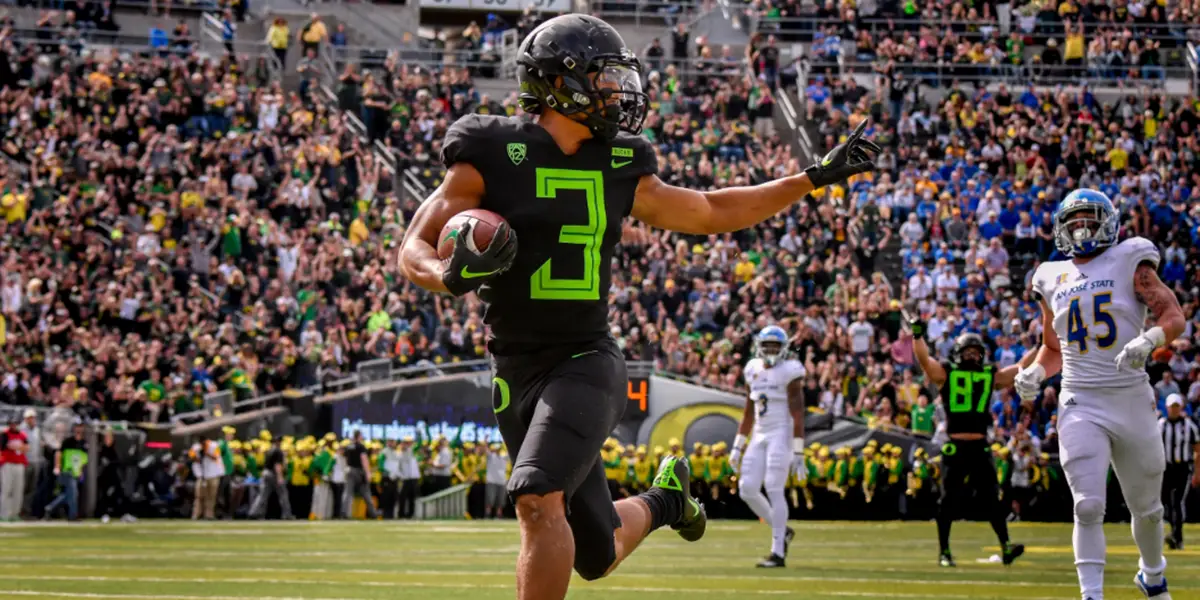Mark Helfrich and Chip Kelly led their respective teams to appearances in the Natty. “Fast, Hard, Finish” was their motto. They scored quickly and they scored often. The Oregon Duck offense was a sight to behold, but they couldn’t bring home a national championship.
Enter Mario Cristobal, who promised to add a physical brand to the Ducks’ version of shock and awe. Although Cristobal implemented seemingly boring plays from the Pistol formation at times last year, I believe we’re about to witness a lethal injection of finish. Let’s delve into what makes a lethal offense, with some glimpses of what improved finishing could bring to Cristobal’s version of Win the Day.
Keep the Defense Guessing
The first key to making your offense “lethal” is to design a set of main plays that get an opponent’s defense to react a certain way. These are your core plays. Then you design a series a plays that look similar to those main plays. These secondary plays are called “sequential plays.” When your opponent sees your offense in a particular formation, they will try to defend the core play first, especially if that core play is routinely successful.
The first play above is one of two core plays Oregon runs from the Pistol formation, a “stretch” or outside zone play (the other core play being inside zone). The second play in the clip is the sequential play, a play-action pass off the same outside zone action from the running back and offensive line. Note how the instant replay of the sequential play shows UW safety Taylor Rapp (No. 7) zooming towards the line of scrimmage in run support.
When Rapp finally recognizes the play-action, he picks up the running back, which leaves Dillon Mitchell in one-on-one coverage. Had the Rapp stayed back, he or cornerback Keith Taylor (No. 27) would have likely helped Myles Bryant (No. 5) cover Mitchell.
Coach Eric Boles also has an example of a sequential play in an article he wrote last October.
You’ll Never Stop Me
Clutch plays are an absolutely necessary for an offense to be lethal. Converting first downs in order to continue drives makes all the difference in the world when it comes to putting points on the scoreboard.
The first play above is a 3rd-down conversion to Juwan Johnson on a simple deep out route; a very difficult route to defend.
The second play is the other core play out of the Pistol, inside zone, complemented by an excellent read from Travis Dye, who cuts outside to convert an important 4th-and-1 play (this drive led to a touchdown, FYI). Playmakers make plays when it is needed. Offensive coordinator Marcus Arroyo likely has a list of several plays he likes to use as clutch plays in given situations to keep drives alive.
The Big Chill
Big plays matter. Plays resulting in at least a 20-yard gain, or long gains for touchdowns (often called “explosion plays”) are lethal and kill a defense’s morale.
In the play above, Marcus Arroyo calls a power play from the Shotgun formation. Dye runs wild for 22 yards. Arroyo followed this play up with the same play, this time for 23 yards. Paging Chip Kelly? Regardless of who is calling the offense, big plays kill a defense’s spirit.
Mike, You’re Still Offering Kool-Aid
The final component defining a lethal offense is the ability to finish.
The drive above features two sequential plays, a core play that gains 11 yards, and at the end of this drive, what should have been the clutch play. Unfortunately, Mitchell dropped a touchdown pass. It was typical of the first three quarters of the game (five “drive-killing” drops going into the fourth quarter).
Arroyo designed his game plan against Michigan State based on its powerful run defense. He wisely crafted sequential plays to keep the Spartans honest. Every successful Duck drive that day stemmed from steady completions that opened up the run game. Those dropped passes not only killed momentum, they destroyed Oregon’s ability to run the ball, and by extension, its game plan.
So what will it take for Oregon to generate a lethal offense this year? Sequential plays, big plays, clutch plays, and most importantly, finishing those plays.
What say you Duck fans? Is Oregon’s offense primed to stoke fear into opposing defenses this year? Or do you believe Arroyo is chopped liver (instead of licking his chops)?
Mike West
Las Vegas, Nevada Top Photo by Eugene Johnson

Spencer Thomas, the FishDuck.com Volunteer Editor for this article, is an attorney for the Social Security Administration in Atlanta, Georgia, and coaches High School Football for Hillgrove HS in Powder Springs, GA.
Mike West was born in Southern California and moved to Eugene in 1976. He attended his first Oregon Football game and watched USC maul the Ducks 63-0. Despite the disappointment he became an avid fan after watching the Rich Brooks show every Sunday in the Fall. After graduating from the University of Oregon, he returned to Los Angeles and enjoyed a career in Customer Service for two decades. Thrilled at the ascent of Oregon Football, he attended both Rose Bowls, living just five miles from the stadium. He now lives in Las Vegas.


